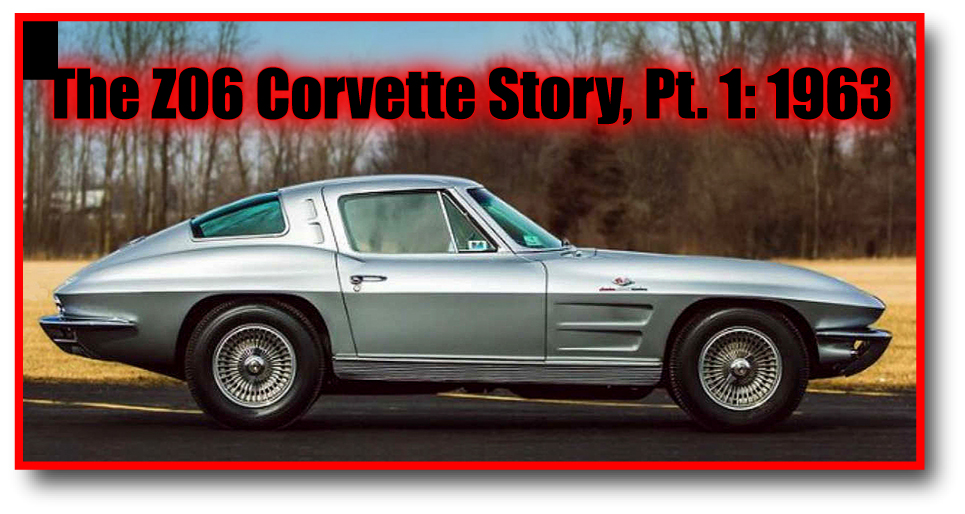For “Off Road” Use Only!
DATELINE: 3-19-22, this story first appeared in the January 2017 issue of Vette Vues Magazine – The C8 mid-engine Corvette is arguably the biggest news in the world of Corvettes since the very beginning in 1953. Many of us thought Chevrolet would never offer such a Corvette, but here we are. And thanks to an established pattern of performance track-model Corvettes that started in 2001 when Chevrolet decided to brand the car, “Z06” after the one-year-only 1963 Corvette, subsequent new model Corvettes have offered a Z06 model. Within minutes after the C6, C7, and now C8 Corvettes were debuted, fans’ second question (after “how much is the new Vette?”) is, “Where’s the Z06?” Yes, we expect it and Chevrolet has not let us down since.
As of this writing, Chevrolet has their Traveling Road Show in full-swing at select Chevrolet dealers to show the loyal faithful exactly what the new C8 Z06 is all about. On March 25, 2022, Stingray Chevrolet, in Plant City, Florida will be hosting their C8 Z06 presentation. No doubt, owner Steve Hurley will put on a fantastic presentation.
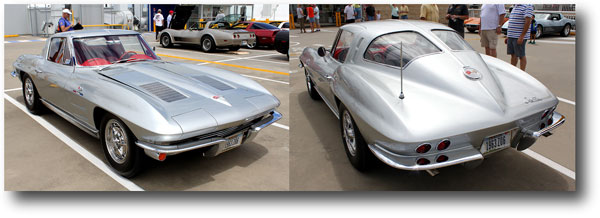
So, with that in mind, the next dozen or so posts here on Corvette Report will present stories I have written for Vette Vues Magazine over the last ten years about the Z06. The C8 Z06 did not arrive from nowhere, there’s been a progression of Z06 Corvettes that go back nearly 70 years to 1963 when “RPO-Z06” was an obscure, one-year-only “racer kit” option that Zora Arkus-Duntov seeded into the 1963 Corvette option list that was essentially a “suspension and brakes” option on top of the L84 Fuelie. There were no external badges or special body enhancement and the car looked like any other Fuelie Corvette. And truthfully, unless a customer wanted to go road racing with their new Corvette, the Z06’s performance suspension and brakes were of little value on the street. There was no fanfare and after 1963, no one but Zora and his hardcore racer friends missed the Z06, so the Z06 faded into Corvette history; that it until the release of the 2001 model year. Ever since then, the Z06 was THE track weapon for Corvette racers.
So, let’s have a look at how we got to where we are with the C8 Z06. It is arguably the most exciting story in Corvette history. – Scott
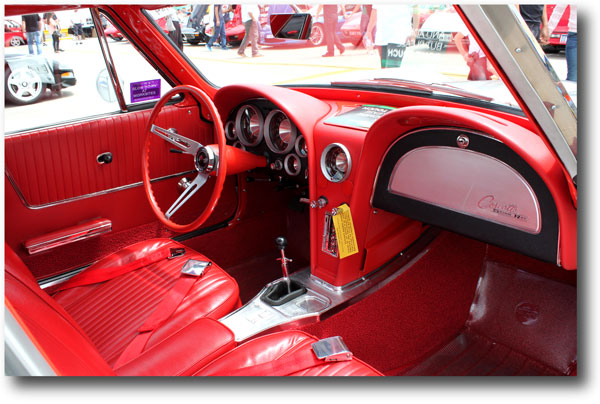
When I was a wee lad and would see the term, “For Off-Road Use Only” I used to think, “Well who drives these cars in the dirt and grass?” What I didn’t understand was that the term is code for “RACING”! Beginning in 1957, Chevrolet’s new general manager, Ed Cole, made the command decision that he would let “customers” carry the Corvette racing mantle by offering Chevrolet-engineered parts, specifically designed for racing, available through the Chevrolet Parts Department.
For decades, Zora Arkus-Duntov has been credited for the implementation of the Corvette “Racer Kits” through the RPO (Regular Production Option) system. Zora was the face of the unofficial Corvette racing effort, but while researching C1 Corvette chassis design, I came across some interesting information in Karl Ludvigsen’s 2014 book, “CORVETTE: America’s Star-Spangled Sports Car”. While Duntov was definitely the frontman, Ed Cole also charged three-time Indy 500 winner and engineer, Mauri Rose with the development of the Corvette’s RPO parts program. So, the Corvette “Off-Road” RPO effort guided by Le Mans racer and class winner, Duntov, AND Mauri Rose, the second man to win the Indy 500 three times (1941, 1947, and 1948)! Pretty cool, huh?
The Racer Kits weren’t a “secret” but unless customers were tuned into racing, most weren’t aware of this special program. In truth, since improvements in suspension and brakes were for racing, customers rarely used them for their street Corvettes. And typically racers used the expensive dual quad or Fuel Injection performance engines. The Racer Kit RPO option program enabled Corvette racers to be seriously competitive in SCCA racing such that by the end of the 1950s, Corvettes were a force to be reckoned with.
Engineer Maurice Olley designed the chassis and suspension of the first Corvette in 1952 and was considered to be the best suspension and chassis engineer in Detroit. It is essential to remember that the Corvette was NOT designed to be a racecar. Chevrolet stated this when the car was first shown at the 1953 Motorama. However, Duntov never wanted to do anything but race the Corvette and in doing so, found the suspension woefully inadequate. Consequently, the C1 got a bad rap and is typically described as a “parts bin” car. This is not completely accurate. While many of the parts look similar to Chevrolet sedan hardware, everything was specifically designed for the Corvette. Mauri Rose led the development effort of the basic chassis and suspension based on Olley’s design – it all had to start somewhere.
While the original suspension calibrations left a lot to be desired for racing, the basic chassis/suspension design never changed. Thanks to the lead work of Duntov, Rose, and their engineer staff, shocks, springs, anti-roll bars, caster & camber settings, and brakes were all honed and developed. From a structure and design standpoint, there’s little difference between a 1953 and a 1962 Corvette. The car that became a dominant force in SCCA racing used the chassis and suspension that Olley designed.
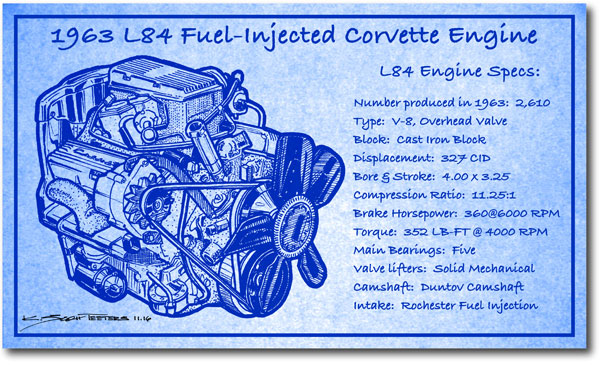
When the decision was made in 1959 that there would be an all-new Corvette, the design and engineering team was totally different. Harley Earl was retired and his protégé, Bill Mitchell would drive the new look of the Corvette and Duntov was there making sure that the new structure would be a vastly improved platform. The new structure would be stronger, designed with a much lower center of gravity, and have four-wheel independent suspension – three key design elements necessary for a racecar. When the new Sting Ray was released in the Fall of 1962, the only major carryover parts were the engine and transmission – everything else was new.
Corvette racers never had a better friend than Zora Arkus-Duntov. After the heavy lifting was completed and the new Sting Ray’s design was basically finished, Duntov and his team set out to create their Racer Kit for the new car. It is not known exactly how the moniker “Z06” was chosen, perhaps by chance, but it sure sounded sexy and no one knew that almost 40 years later there would be a separate performance model with the heart and soul of the Racer Kit, wearing a Z06 badge.
Racer Kits were never been cheap and the Z06 package was the most expensive Corvette option offered to that date, costing $1,818. But there were other options that were mandatory for the Z06. Those options included the L84 Fuel-Injected 327, the close-ratio 4-speed transmission, and the positraction rear axle. These goodies added an extra $661, for a complete price of $2,479, on top of the $4,252 base price of the car, for a total of $6,731. Then, with a few other extras, tax, tags, registration, etc, buyers were looking at a $7,000 Corvette in 1963! You could buy a loaded ‘63 SS Impala for around $3,000.
The hardware included in the Z06 package was amazing for its time. With plenty of power on tap, Z06 extras were designed to enhance the suspension and brakes – critical elements for racing. The front suspension had stiffer shocks, beefier springs, and a thicker, .94-inch stabilized bar. The rear suspension had a 7-leaf transverse spring – two more than the stock setup. To fit the larger 7.75 x 15 racing tires, the rear inner wheel wells were wider. Not all Z06 cars had the Kelsey-Hayes knockoff wheels due to problems with porosity issues. To reduce the number of pit stops, a 36.5-gallon fiberglass gas tank was included. Interestingly, this part of the Z06 would remain an option through to ’67.
But the really big advancement was the braking system. There’s nothing worse than going fast with inadequate brakes. The new system was complete, from its new vacuum-assisted, dual-circuit master cylinder to new finned brake drums. Each brake has a cooling fan built onto the hubs to pull air into the brake drums. The brake plate had a wire mesh and a scoop mounted to the inside of the plate. To complete the new cooling system, each brake drum had 5 vent holes. The Cerametallix brake shoes (this was a different pad compound than the typical sintered-lined shoes) were not for street use and were almost useless until heated up. Unlike the modern Z06, this package was not designed to be driven on the street. Z06s were streetable, but they were nosey, hard-riding cars.
So, how did all this work out for Corvette racers? Actually pretty good! Duntov seeded the first six Z06 Corvettes to select racers in September 1962 to be prepped for the L.A. Time Three Hour International, in October. In retrospect, it is astonishing that they would only a lot a few weeks to prep untested cars for a major race. Mickey Thompson had his Z06 shipped to his shop in the Los Angeles area. Duntov had racers Dave MacDonald (and his lovely wife Sherry), Bob Bondurant, and Jerry Grant flew to St. Louis to pick up their Corvettes to be driven back to California and Grant drove to Washington state – the engines had to be broken in, right?
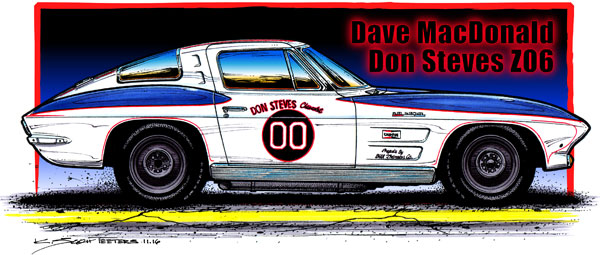
Sherry MacDonald related to me the story of how in the desert she had the car at 140-mph, with Dave telling her, “Go faster! Go faster!” Doug MacDonald (Dave’s younger brother) told me that when Dave and Sherry arrived home in their new, white Sting Ray, there were cars of gawkers following them because no one had seen the new Sting Ray! MacDonald’s Don Steves Chevrolet Z06 was the very first Z06 off the line, VIN#684. “684” also happens to be the RPO number of the first Duntov Racer Kit offered in 1957, “RPO684 Heavy Duty Racing Suspension.”
The Z06 Sting Rays weren’t the only American sports car racecars that debuted at the Riverside event. Carroll Shelby was also there with his new track weapon, the Cobra. Why the Cobra and the Corvette were allowed to race in the same class is a mystery, but they did, despite the Cobra’s 1,000-pound advantage. Anything can go wrong in an endurance race, even the simplest things. In the first hour, hard-charging MacDonald fought Billy Krause, driving the Cobra. Just before the end of the first hour, within minutes of one another, the rear wheel of MacDonald’s Z06 and Krauss’ Cobra came off, most likely due to one or more loose lug nuts.
Later in the second hour, the engines in the Bondurant and Grant cars let go, leaving Thompson’s Z06, driven by Doug Hooper to win the race. Thompson, ever the showman, proclaimed, “I don’t think its ever been done before! A new production car winning the first time out.” While a “win is a win,” and it was a great start for the Z06 Sting Ray, for the most part, Corvettes would be chasing after Cobras until Duntov’s L88 arrived in 1967. Ironically this was the last time MacDonald ever professionally raced a Corvette. By the end of 1962, Shelby offered MacDonald a golden opportunity as a full-time driver.
But there is a happy ending for the 1963 Z06 Sting Ray. Racer Grady Davis won the 1962 SCCA B/production Championship with his 327 fuel-injected ’62 Corvette. This was indeed the crowning glory for the C1 Corvette racecars. Of the Z06 cars assigned by Duntov to be loaned to select teams, Davis received two cars. The Gulf One car illustrated here saw more track action than any of the other assigned Z06 cars. The car’s first outing was at the ‘63 Puerto Rico Grand Prix where Dr. Dick Thompson drove the car to its first class win. Then in January 1963, the car won at the Refrigerator Bowl in Marlboro, Maryland. After being prepared for FIA rules to race at the Daytona Continental and Sebring, Thompson drove the car to 3rd overall and first in GT3 class at Daytona, but the transmission broke at the Sebring race in March ‘63. Thompson went on to score even wins at the SCCA’s President’s Cup race in Marlboro, an A/Production class win in Danville, Virginia, and Road America in Elkhart Lake, Wisconsin.
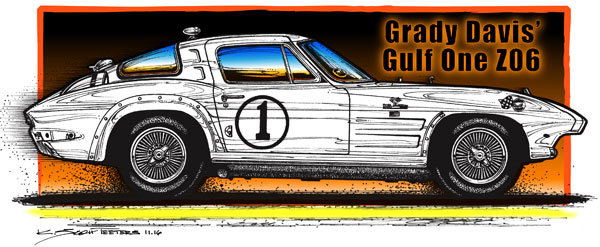
Like most racecars, the Gulf One was sold and bought many times. In January 2009, the audience attending the Mecum Muscle Cars & More Auction got to witness the truly historic ‘63 “Gulf One” racing Z06 Corvette sell for over $1 million dollars. In fact, the winning bid was $1,113,000. Needless to say, the crowd went wild. While not the highest price ever paid for a Corvette at auction, any time a 46-year old car that originally cost approximately $5,300 new in 1963 sells for over one million dollars, it’s an exciting thing. You can watch an 8-minute video of the auction at YouTube.com.
After 1963, interest in the Z06 cars was pretty much gone until the moniker came back in ’01. While Chevrolet seems to have saved the moniker “ZR1” for the most extreme street Corvettes, “Z06” has been reserved for what it was originally designed to be – a racer. While the C5 Z06 was an awesome street and track performer, the C6 Z06 turned out to be more racer than many buyers bargained for. Today, many road testers have commented that if the C7 Z06 did not have its computer-controlled suspension system, it would be undrivable at the limit. It is astonishing how far the once suspension and brakes Racer Kit has come!
Next in this series we’ll take a look back at Chevrolet’s second “performance model” (the first being the C4 ZR1) Corvette, the 2001-2004 C5 Z06. – Scott

https://vette-vues.com/product/subscribe/

